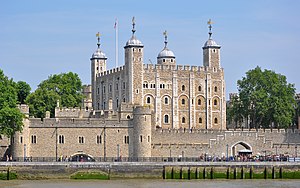Liberties of the Tower of London
| Liberties of the Tower of London Tower Liberty |
|
|---|---|
| Liberty | |

The Tower of London
|
|
| Area | |
| • Coordinates | 51°30′29″N 0°04′34″W / 51.5080°N 0.0762°WCoordinates: 51°30′29″N 0°04′34″W / 51.5080°N 0.0762°W |
| Population | |
| • 1831 | 4,190 |
| History | |
| • Abolished | 25 June 1894 |
| Government | Tower Liberty Quarter Sessions |
| • Type | Quarter sessions court |
| • HQ | Court House, Wellclose Square |
| Subdivisions | |
| • Type | Places |
| • Units |
|
The Liberties of the Tower, or the Tower Liberty, was a liberty around and including the Tower of London. It was outside the jurisdiction of the City of London and the County of Middlesex, with its own county government. The area of the liberty expanded in 1686. It became part of the County of London in 1889 and was dissolved in 1894.
The liberty originally consisted of the area inside the walls of the Tower of London (also known as Tower Within) and immediately outside it (known as Old Tower Without). The boundaries were presented by a Leet Jury in 1525 and again as surveyed by Haiward and Gascoyne in 1597.
In 1686 letters patent granted by James II added the Old Artillery Ground, Little Minories and the Liberty of Wellclose. These areas came into the possession of the Crown when the religious houses that formerly administered them were dissolved. They had subsequently been used for the storing of ordnance.
The population was 3,995 in 1811 and 4,190 in 1831.
The liberties had an administration separate from the neighbouring county and city, headed by the Constable of the Tower of London, and appointed their own coroner, and had their own courthouse with general and quarter sessions and gaol. A force of constables was appointed for the area. The inhabitants had certain other privileges such as being able to claim any beast that fell from, and any swans under London Bridge.
From 1837 the liberty formed part of the Whitechapel Poor Law Union. Extra-parochial places were progressively eliminated and following the Extra-Parochial Places Act 1857, the Tower of London and Old Tower Without became civil parishes in 1858. The Old Artillery Ground became a civil parish in 1866, following the Poor Law Amendment Act 1866.
...
Wikipedia
